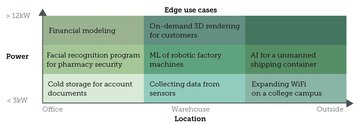Everything’s got to change, we hear. Computing has to move from big data centers to the “Edge” of the network, closer to users. Is this just a periodic surge of hype for a new buzzword, or is real change happening?
As with all hype, we can predict two things. Firstly, Edge will change. The Edge that succeeds won’t be the Edge that is being debated now, just as the things you are doing with mobile data aren’t the things that were predicted ten or twenty years ago. And secondly, if and when Edge wins, you’ll never hear the term again, because it will be like air; all around without needing a second thought.
The Green IT of 2018
What is Edge right now? According to some, it describes micro facilities at cell towers. Others say it represents responsive applications, wherever they happen to be. Today, we centralize computing in remote locations, to benefit from economies of scale. But as processing and content distribution requirements grow, compute will be needed to be placed ten miles, five miles or less from the end-user.
“The smart thinker’s answer is that the Edge is at the telecoms base station,” Peter Hopton, the founder and CEO of liquid cooling systems provider Iceotope, told DCD. Usually “within a mile and a half to two miles from your location,” mobile network towers are also increasingly used for media content on phones, for smart vehicles, and for the sensors which make up the Internet of Things (IoT).
But the Edge will go further than this. The next generation of mobile networks, 5G, is still being defined; it promises faster links - but over a shorter range. Cell towers are “going to be getting a lot closer,” as close as “hundreds of meters” away.
Just as Green IT was a great marketing buzzword ten years ago, Edge is the marketing gold mine of the moment. But Hopton says it is a real trend, and those who grasp it will “come out on top.”
Edge also helps handle the change in the way data circulates. “It used to be that everything was made in Hollywood and distributed to customers. We had huge downloads but small uploads,” Hopton explained.
“With the growth of social media, everyone wants to be a YouTuber and upload their own content. Data is now coming from the customer and being distributed from point to point. It’s no longer from the core outwards, it’s from the outside back to the core and then back out again.”
This new dynamic is likely to evolve further as new technologies emerge.
Developing and commercializing these technologies may be dependent on the Edge’s distributed infrastructure, but some distributed approaches already exist, and will be improved by it.
Before it was cool
Arguably the oldest Edge companies are content delivery networks (CDNs) such as Akamai. For them (see below), the Edge has evolved into a protective shield that keeps content safe against attacks and outages.
For the newcomers, Edge is up for reevaluation. A group of vendors including Vapor IO, bare metal cloud provider Packet and Arm recently published a report detailing their understanding of Edge and defining its terms. The State of the Edge describes the creation of Edge native applications, but points out that some apps may merely be enhanced by the availability of local processing power.
Some companies already run applications that rely on distributed infrastructure: HPE, which recently announced a $4bn investment in Edge technologies, said this model is being used in large businesses and stadiums enabling WiFi connectivity; and in manufacturing environments, for predictive maintenance.
For example, Colin I’Anson, an HPE fellow and the company’s chief technologist for Edge, said its IoT sensors and servers are used by participants in the Formula 1 Grand Prix for airflow dynamics: "There are rules from the FIA and they allow you to only have a certain amount of energy use, a certain amount of compute use.
“We've purposed that capability for the IoT so we've got a low power ability to place a good server down at the Edge. We are capable then of running significant workloads.”
On this basis, it’s clear that Edge is not a single thing, but a dynamic term, for a dynamic set of functions, delivered on a highly varied set of hardware.
This article appeared in the August/September issue of DCD magazine. Subscribe for free today:


